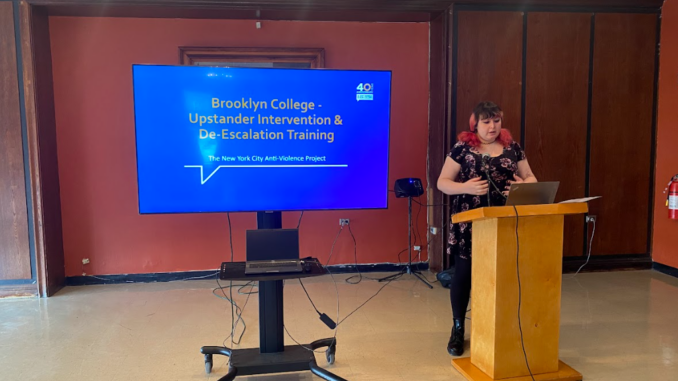
By Giovanni Ravalli
In honor of Trans Day of Visibility, the LGBTQ+ Center hosted the New York City “Anti-Violence Project for Upstander Intervention and De-Escalation” training on Tuesday, March 26.
The workshop was presented by Delilah Seligman of the NYC Anti-Violence Project. The aim was to empower people to become effective upstanders in circumstances of hate violence. Hate violence is any form of violence to a human being belonging to a marginalized group resulting from biased prejudices. It can occur anywhere–on the street, public transit, work, home, places of worship–even over the internet.
Trans people are on the receiving end of a rise in reactivity and violence due to being hypervisible. As a result of being so easily seen, the transgender community experiences a disproportionately higher rate of violence. “Visibility without protection is still violence. Since coming out as a transwoman, I’ve absolutely dealt with a ton of street harassment and violence,” said Seligman. “Definitely a lot of anxiety and hypervigilance out in the streets. The lived experience makes it really important for me to want to do more to help people.”
A bystander is someone who witnesses hate violence and doesn’t get involved. In contrast to a bystander, an “upstander” will intervene in support of the victim of being harrassed, intimidated, discriminated against, attacked, bullied or otherwise dehumanized. This is done by utilizing the project’s five D’s of upstander action: “Direct-confronting the perpetrator; Delegate-assess the situation, risk level and assign tasks to others; Distract-taking attention away from the perpetrator, victim or the situation; Delay-checking in with the victim; Document-record the incident on your phone for evidence purposes.”
During the visualization and role play exercises, participants were able to practice deep breathing along with a self scan of internal thoughts and feelings as well as environment scan techniques to assess the scene for safety. Not all tools are appropriate for every situation. Distraction may work in some instances, while other times being direct is a better approach. Best to use discretion when discerning the safety of getting involved. If it isn’t safe, then delegation is a better option. The priority is to ensure you and the victim get out of the scene safely.
The NYC Anti-Violence Project has provided a 24-hour crisis hotline service since 1985. Trained volunteer counselors offer option clarification and assist by connecting survivors with needed resources, help with accessing law enforcement, counseling and legal assistance. The Anti-Violence Project is involved in policy legislation and education to recognize hate speech as a crime.
“I’ve been in the LGBT non-profit world for many years now,” said Seligman. “The work that we do, it’s so important to practice what we preach, and so this is stuff that we’re trying to do and that’s part of the reason we go into the community is to train folks to try and do better in the world and take care of each other.”
The NYC Anti-Violence Project started as a volunteer organization in 1980 as a response to an alarming increase in violence against gay men at that time. Their mission is to empower LGBTQ+ communities and allies to end all forms of violence through organizing and education, supporting survivors through counseling and advocacy. The NYC Anti-Violence Project is now the largest anti-LGBTQ+ violence organization in the country and coordinates the National Coalition of Anti-Violence Programs to facilitate systemic and social change.
“The idea for the workshop originally came from an Art Department professor Christopher Richards, who often experiences ridicule or worse for his outwardly flamboyant clothing choices, and unapologetically ‘gay’ appearance,” said Kelly Spivey, director of the LGBTQ+ Resource Center. “He experiences verbal harassment on the subway and on the street, not necessarily on campus, but he wondered if we could all benefit from learning skills to help if we are targeted or if we witness someone being targeted; thus the workshop title ‘bystander’ training.”
Everyone has their own experiences with discrimination in some way. When a social identity overlaps with another one, or more, this is called intersectionality. As Seligman explained, “We all have different identities. Different identities have different privileges.”
“I think it’s a really important conversation to have because I myself have often felt unsafe and because of my own experiences I thought it’d be a good event for us to have,” said Richards. “I think it’s good because sometimes students don’t want to verbalize the feeling of being unsafe, so I think it’s a nice way to allow them to have that conversation and give them some really thoughtful tactics which are really helpful.”
Understanding intersectionality is crucial for encouraging diversity, equity and inclusivity, according to organizers. It allows us to recognize and address the unique experiences and challenges faced by those with intersecting identities.
“Hopefully we will have more events that really celebrate who we are and make us feel safe, accepted, and seen,” said Richards.
Students interested in learning more about The NYC Anti-Violence Project can visit https://www.AVP.org and students interested in learning more about the LGBTQ+ Resource Center can visit https://www.brooklyn.edu/lgbtq-center/ or visit their office in 219-221 Student Center.
